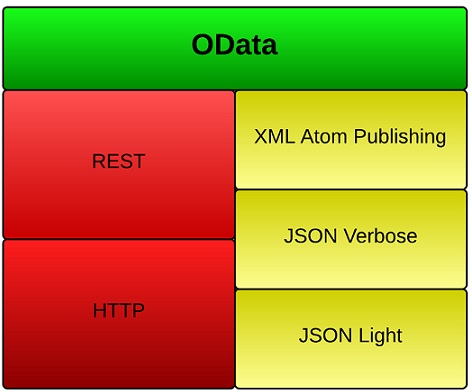In my previous tutorial, we’ve covered different aspects of how to Build RESTful service using ASP.NET Web API. In this multi-part series tutorial, we’ll be building OData service following the same REST architecture we’ve talked about previously.
Before jumping into the code samples, let’s talk a little bit about OData definition and specifications.
OData Introduction
OData stands for Open Data Protocol. It is standard for providing access to data over the internet, OData is championed by Microsoft as an open specification and adopted by many different platforms. By using OData, it will allow you to build a uniform way to expose full featured data APIs (Querying, Updating), the nice thing about OData is that it builds on top of mature standard web technologies and protocols such as HTTP, Atom Publishing Protocol, JSON, and follows the REST architecture in order to provide data access from different applications, services and data stores.
It is well known that any service follows the REST principles that will adhere to the aspects below:
- Resources are identified by a unique URI only
- Actions on the resource should be done using using HTTP verbs (
GET, POST, PUT, and DELETE). - Enable content negotiation to allow clients specifying the format of the data type returned: XML format (AtomPub), or JSON format (Verbose/Light).

Querying Existing OData Service
Before we start building our OData service, let’s examine querying an existing OData service published on the internet and use the Northwind database. The base URI for this service is http://services.odata.org/Northwind/Northwind.svc. You can use any REST client such as (Fiddler, PostMan) to compose those HTTP requests, as we are only querying the service now (no sending updates) you can use your favorite browser as well. Note that you can use Linq4Pad to generate and test complex OData queries.
The tables below illustrates some of the OData query options which can be used to query the service:
| Option | OData Service URL | Notes |
$filter | http://services.odata.org/Northwind/Northwind.svc/Products?$filter=ProductName eq 'Tofu' | Filter the results based on Boolean condition, i.e., get product name = 'Tofu' |
$orderby | http://services.odata.org/Northwind/Northwind.svc/Products?$orderby=ProductName | Sort the results, i.e., Sort the products by Product Name |
$skip | http://services.odata.org/Northwind/Northwind.svc/Products?$skip=10 | Skip the first n results, used for server side paging |
$top | http://services.odata.org/Northwind/Northwind.svc/Products?$top=10 | Returns only the first n results, used for server side paging |
$select | http://services.odata.org/Northwind/Northwind.svc/Products?$filter=ProductName eq 'Tofu'&$select=ProductName,UnitPrice | Select which properties to be returned in the response, i.e., returning ProductName and UnitPrice |
$expand | http://services.odata.org/Northwind/Northwind.svc/Products?$expand=Supplier | Expand the related entities inline, i.e., expand the supplier entity for each product |
$inlinecount | http://services.odata.org/Northwind/Northwind.svc/Products?$inlinecount=allpages | Inform the server to return the total count of matching records in the response. |
<!-- #tablepress-1 from cache -->
As we see in the table above, we can combine different query options together and provide complex search criteria, for example, if we want to implement server side paging, we can issue the following HTTP GET request: http://services.odata.org/Northwind/Northwind.svc/Products?$top=10&$skip=0&$orderby=ProductName&$inlinecount=allpages where $skip represents the number of records to skip usually (PageSize x PageIndex) and $inlinecount represents the total number of products. To view the complete list of available query options, you can visit this link.
As we stated before, OData service allows content negotiation, so the client can choose the response format by setting the Accept header of the request, each response format has its own pros and cons. The table below illustrates the differences:
| | XML (Atom Publishing) | JSON Verbose | JSON Light |
| OData Version | Version 1, 2, and 3 | Version 1, 2 and 3 | Version 3 |
| Metadata and Hyper Links | Data and MetaData | Data and Metadata | No Metadata, Just the Data |
| Payload Size for all Products entity | 28.67 KBs | 14.34 KBs, smaller by 50% | 4.25 KBs, smaller by 75% |
| Easy to consume in mobile clients | No | Yes | Yes |
| Accept Header | application/atom+xml | application/json;odata=verbose | application/json |
<!-- #tablepress-2 from cache -->
I’ve decided to split this tutorial into four parts as the below:
The source code for this series is available on GitHub, you can download it locally or you can fork it. If you have any question or if there is nothing unclear, please drop me a comment.
The post Building OData Service using ASP.Net Web API Tutorial – Part 1 appeared first on Bit of Technology.
Working for Microsoft Consultation Services as a Lead App Dev Consultant.
I have more than 15 years of experience in developing and managing different software solutions for the finance, transportation, logistics, and e-commerce sectors. I’ve been deeply involved in .NET development since early framework versions and currently, I work on different technologies on the ASP.NET stack with a deep passion for Web API, Distributed systems, Microservices, and Microsoft Azure.
Prior to joining Microsoft, I have been awarded the Microsoft Most Valuable Professional (MVP) Award for the years 2015 and 2016 in Visual Studio and Development Technologies, also I’m a regular speaker in local events and Dev user groups.




